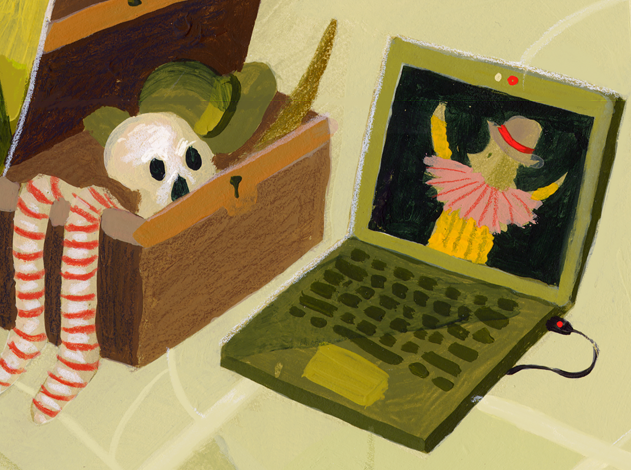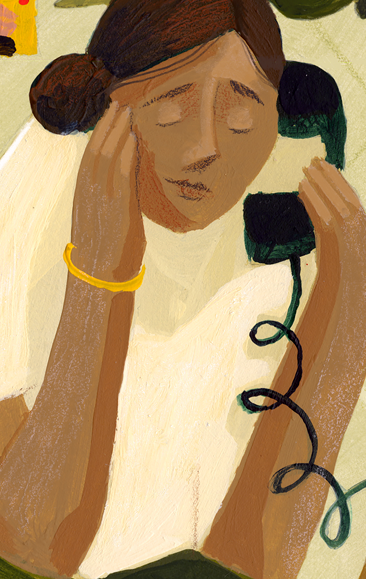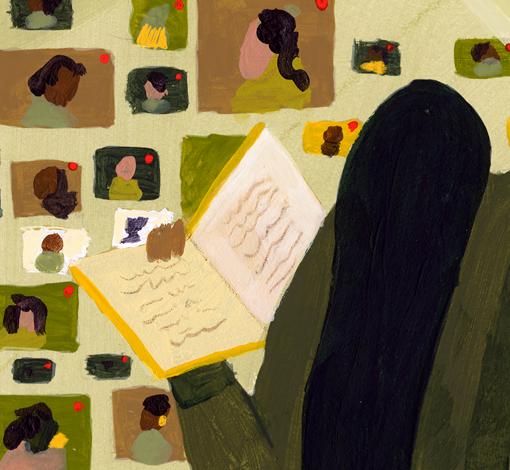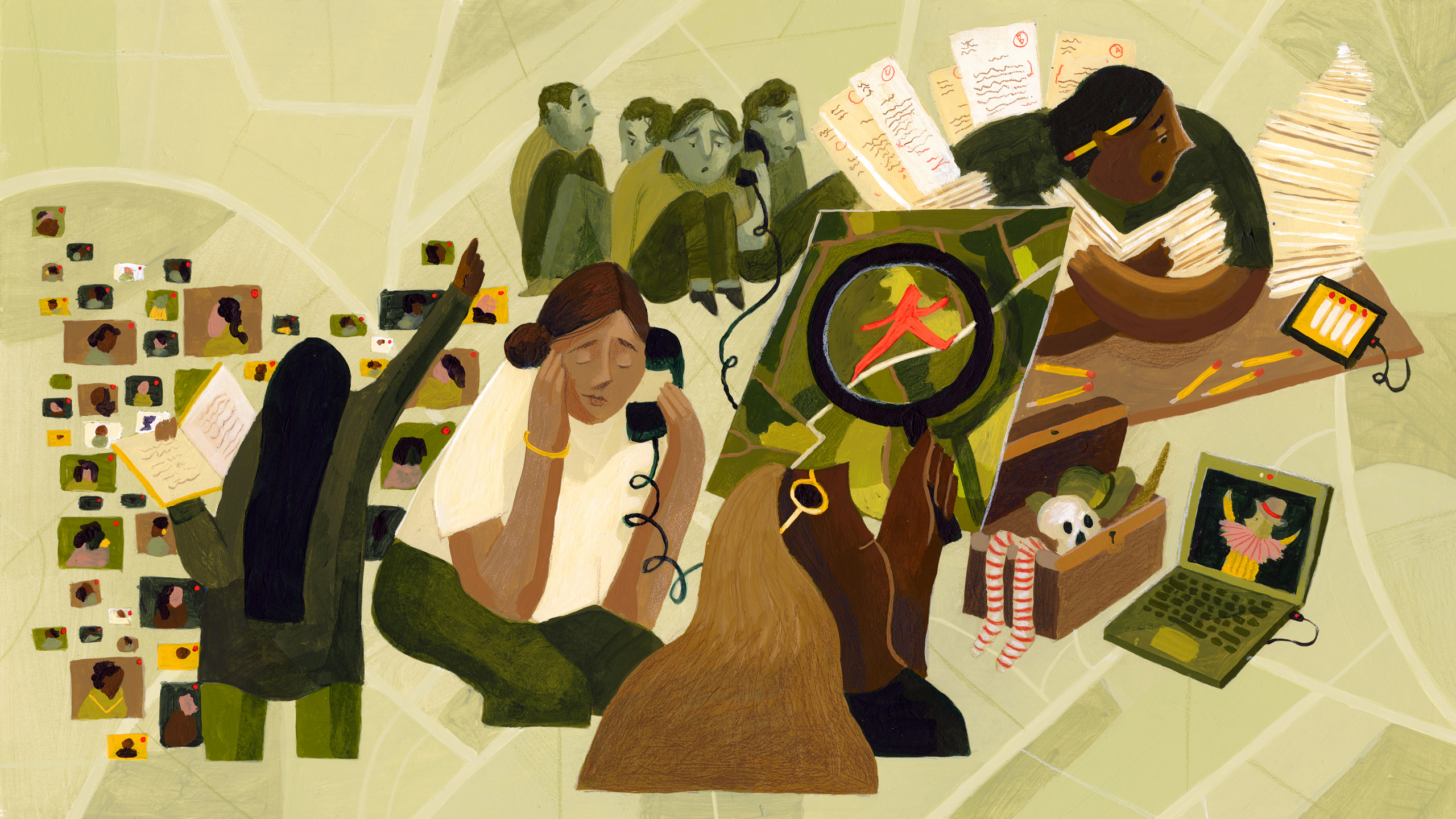At first, pockets of schools and school districts began to close, one by one. And then, seemingly overnight, they all did, in one big rush.
Last spring, COVID-19 emptied the nation’s schoolhouses and classrooms, upending ritual and routine—and leaving teachers to figure out how they would continue to educate students. We checked in with five such educators—all seeking or having attained master’s degrees from the Bread Loaf School of English—to learn how they have fared. These are their stories.
In Isolation, Already
Millinocket, Maine, is an old mill town of around 4,000 people at the edge of the North Maine Woods, a remote, compact little place surrounded by wilderness. For the past two years, Anna Loome, who is currently pursuing her master’s at Bread Loaf, has been teaching seventh- and eighth-grade English, as well as geology and outdoor education, at Stearns Junior/Senior High School in the community.
“We’re a small school,” she says, “276 students in grades 6–12. Our population is mostly working and middle class and 98 percent white. We have a mix of families, those who have been in the area for generations, and families who are more recent arrivals. Our students experience quite a bit of economic need; 60 percent of students qualify for free and reduced lunch.”
Loome was well into the spring semester when administrators realized what a threat the coronavirus had become and announced that the school would move from in-class instruction to remote learning. With only the space of a weekend to process the news, Loome wondered how she could possibly get prepared, and she had no idea how the students would cope. The Monday after the announcement, she was glad to find that middle school students had the chance to go to the school, pick up their materials, and check in with teachers. “In fact, every single student in our middle school showed up. That was a defining moment for me and it started my remote teaching off on a really hopeful note. It really fueled my desire to show up for my students at this time.”
But the challenges were significant. Just connecting students with the resources they needed to continue learning at home was difficult. The school gave them the option of learning online or doing paperwork at first, but then the district found a way to provide every student with a laptop and an Internet connection. Yet being connected was just the first step. While many of her students engaged and did the work, there were students Loome worried about. “The greatest stressor for me was knowing there were more than a few students I wasn’t able to connect with from the beginning, despite trying every method available to me. I was worried about their academic progress, but more than that, I was worried about them on a personal level.”
At the same time, Loome was seeing some students for whom remote learning was a smoother experience than the daily struggles of middle school in person. “Being able to connect directly with teachers and work on their own timetables, without all the distractions and stresses they have in the building, allowed some kids who usually fly under the radar to thrive.” Loome took advantage of the situation to do more one-on-one work with students on their writing and saw great progress and growth in that area.
A real plus for Loome was the collaboration she was able to do with her colleagues. The social studies teacher brought in guest speakers via Zoom; Loome and another colleague continued to work with students on a newspaper they had been producing, distributing new issues with writing and artwork contributed by students from home. Realizing what social creatures middle schoolers are, Loome helped set up movie nights over Zoom and online game days.
While Loome feels that she and her colleagues successfully navigated a difficult spring, they worry about the fall because of the inequities of experiences the students had during remote learning. If in-class learning returns, Loome realizes that some students will come back to school with skills intact because they did the work and engaged with the teachers. Others, who did not engage, will most likely have lost skills as well as the habits that go with doing the work. Loome and her colleagues have already talked as a team about the strategies they will need to employ with the range of experiences students had through distance learning. “I’ll likely start with some serious review but I’ll have to be thoughtful about it so students who didn’t engage don’t feel lost, and students who did the work don’t feel like it’s all being repeated and they have to do it over.” She adds about the whole remote experience, “I think we all, teachers and students alike, learned a lot—just maybe not what we expected to learn.”

An Early Test Case
School closure came abruptly for Janie Davies Fitzgerald, MA English ’97. She teaches eighth-grade English at Scarsdale Middle School in Scarsdale, New York, next door to New Rochelle, where in early March there was an outbreak of COVID-19. On March 9, Fitzgerald’s school closed without warning when it was learned that 36 people, including her, had been unknowingly exposed on March 4 to someone with the coronavirus. On March 10, Fitzgerald’s family was tested by state nurses who came to their house in protective clothing and masks and simultaneously served them with official Department of Health quarantine orders. She says, “Thankfully all of our tests were negative.”
Retrieving her materials from the school after her quarantine, Fitzgerald set about figuring out how she could teach her classes online. She recognizes her good fortune, as Scarsdale is a wealthy community—not only did all her students have good access to the Internet, the school had invested in Schoology, an online platform where she could push Google Docs and Slides from her Google Drive out to her students, grade assignments, provide comments, create online discussions, and send emails. She also took advantage of the many workshops her district offered, taking 11 different ones on technology to bring her curriculum to life in the virtual classroom. “Nearpod was my favorite new method because I could create live lessons or student-paced lessons, and introduce many other interactive elements into my classes. I really enjoyed the live Nearpod lesson I did in a Zoom class to celebrate Shakespeare’s birthday.”

She taught film, poetry, Romeo and Juliet (what she calls the crown jewel of the eighth-grade English curriculum), and Night by Elie Wiesel with WWII books over the 13-week period. She held Zoom interactive lessons on Mondays and Thursdays and created 38 different video lessons and many Nearpod lessons for the other days. She had students discuss the literature in Zoom breakout rooms. Over two sessions they even did a “Team Investigation of a Theme” for Night and presented it to the class. “I did notice that the introverted and socially anxious kids flourished in this online environment, and the students who are extroverted and more social in their learning found it more difficult than being in the regular classroom.”
She says, “This was my 28th year of teaching middle school English, and it was definitely my hardest. My kids and I were really disappointed we did not have the opportunity to return to Room B128 for in-person classes.” Despite the useful technological tools, she realized how much she missed and valued the discussions she could have with her students in person, as well as the all-important daily interactions that are an integral part of her teaching. “Some of my favorite moments of the virtual classroom time were when I set up individual or small-group extra help sessions on Zoom. I got to chat with the kids and give them the specific help they needed.”
All the screen time, however, was a challenge for Fitzgerald—she was often working 12- to 14-hour days online because of all the emails, meetings, lesson creation, interactive classes, and grading, which made teaching more grueling than ever before. But she is quick to add that the virtual classroom experience also taught her students some valuable lessons about resilience, self-regulation and keeping to a schedule, independence, technology, netiquette in Zoom sessions, and adhering to deadlines.

A Community Widely Dispersed
At Santa Fe Indian School, Susan Miera, MA English ’97, was overseeing a student-run writing center and teaching a senior English credit recovery class for five seniors who had failed English IV the first semester when the orders came to close the school and switch to remote learning. Since the school is a Native boarding school owned and operated by the 19 pueblos of the state of New Mexico, the 700 students dispersed back to their Native communities across the state. The school did what it could to provide them with access to materials. Interdisciplinary packets were created to meet both academic requirements and the core values of the school. These packets were delivered or mailed to every student enrolled at the time. But because of the inequity of Internet access in Indian Country, staff needed to think outside the box. She says, “Those students with Internet access could and did complete assignments online. Many more used telephone data packages, phone conversations, text messages, email messages, pictures of assignments, and snail mail to complete the required work. School secretaries scanned assignments received by snail mail and emailed them to teachers for grading.”
With no work in the writing center, Miera continued the credit recovery class for the five seniors. She used Google Classroom and Zoom for online classes, but Internet is spotty across the different pueblos, and spikes in COVID-19 cases created stress and fear for the students. Because of the limited housing in pueblos and on Navajo reservations, many multigenerational families live together. Classes became the least of the worries for the young people. She says, “I spent a lot of time on the phone, talking them through assignments and cajoling them into action. Some were relying solely on data plans on their phones for access, so I allowed them to take photos of completed assignments and send them to me via text messages.”

Despite the challenges, her students all passed and received credit for the first semester. When the credit recovery class finished, she became the online writing center resource for seniors’ final research papers. Seniors take a yearlong research class, known as their Senior Honors Project, and research a contemporary issue in their pueblos/Native communities and present their findings to their communities at a symposium. Before submitting their papers to their teachers for final evaluation, they shared them with Miera, who gave feedback, mainly to make sure they were on track. All the interactions had to be done by phone, which was not always easy, but in the end the seniors completed their papers.
Times have not gotten any easier, however, and it’s unknown if students will be able to return in the fall. COVID-19 has continued its spread throughout New Mexico, with Pueblo and Navajo communities being hit hardest. Inequitable access to medical supplies, food, and water, combined with great distances between towns, grocery stores, and medical facilities on Navajo, often puts schoolwork on the back burner.
Miera notes that when students come to the Santa Fe Indian School during regular operation, they come to a cohesive community that offers them many of the things they lack at home, so during the distance learning, staff had to think creatively to address issues of equity during the uncertain times. “We also needed to understand and be empathetic to the fact that most of the students had, and continue to be, personally impacted by this pandemic.” Yet, she feels, having students problem solve, practice traditional and cultural activities, write about their experiences, and learn hard lessons about resiliency trumped anything teachers could do in a regular classroom and made them better lifelong learners. “In retrospect as I reflect on the teaching during this time, the experience must make us better teachers and learners, as well, or we do a disservice to our profession.”

Tales of Two Realities
Anjali Nirmalan, a current Bread Loaf student, taught for seven years at a Title 1 school in the Boston Public Schools (BPS) system, where the student body was 99 percent students of color and where she had to fight for years to get just one cart of Chromebooks for her grade level. So it was a culture shock when she moved to Mexico and began teaching 9th- and 11th-grade English at the American School Foundation in Monterrey. She says, “Even though I moved from a majority Latinx district to a school that is 95 percent Mexican, the students are primarily white passing and reside in one of the wealthiest zip codes in Latin America.” For the first time, she was working in a fully resourced school where she was able to pair rigorous literature with multimedia projects like documentaries, podcasts, and TED Talks. “Everything I wish I had been able to do at my last school.”

When COVID-19 began forcing schools to send students home and teachers to teach remotely, she was well set up to shift her lesson plans online with a multitude of online resources to let her teach her classes in the best possible way. But, she says, “I was still in touch with students and teachers at my previous school and our contrasting experiences were thrown into sharp relief. While my new school began developing a distance learning plan in January—with its global view of what was already happening in Asia—and started leading professional development on remote teaching by February, my old school was left scrambling in March without the district providing a clear plan or resources to make online learning a reality for the students who need it most.” Her own students were armed with MacBooks and AirPods; the BPS was finally buying 40,000 Chromebooks in April for students. She thought, “Do you mean to tell me we could have set up our students in Boston with equitable resources at any time, but we waited until the excuse of a crisis to do it?” She was teaching her daily Zoom classes to engaged students, who were able to access the web tools she uses such as Google Drive, Classroom, Hangouts, and Chat for class discussion and announcements, Google Slides for presentations, and Google Forms for quizzes. Meanwhile, her BPS colleagues were investing the bulk of their time in trying to reach families, check in on their students’ socioemotional health, and share out any academic work.
She worries that when the pandemic hit, education for many low-income students across the U.S. ground to a complete halt, which terrifies and infuriates her. “I know how hard it already is to teach in an underresourced school; I can’t imagine how those same teachers can succeed remotely, when so much comes down to authentic relationships and providing both physical and psychological safety in the classroom. A screen is simply not the same. My BPS colleagues were prioritizing exactly what their students needed at the moment. But this situation highlights the broken social systems that result in teachers at Title 1 schools always having to make sure their students are safe, fed, and healthy before they are ready to learn—whether in person or online.” Meanwhile, her students were leading Socratic seminars in Zoom breakout rooms and preparing for online AP exams that their teachers had pivoted on a dime to prepare them for. “That doesn’t come down to luck; it entirely reflects the inequity that already existed and is being further exacerbated every day.”

Among the Vulnerable
After teaching in the Duxbury, Massachusetts, public schools for 19 years, Renee Lewin, MA English ’07, moved to Vermont, a place she had fallen in love with, and looked for a new teaching experience. She had several job choices and ultimately accepted a teaching position at the Kindle Farm School, a behavioral and therapeutic day school for boys in Townshend, Vermont. Her students are at-risk youth who live on or below the poverty line. Of the three programs at the school—Kindle Farm Central for grades 3–7, the Farmhouse for grades 6–12, and the Outback for just high school students—she teaches English in the Outback, which is literally the three buildings that are “out back” of the farmhouse—including a yurt, which is her classroom. There are four homerooms of six boys and they travel from class to class with a classroom assistant who is available for academic and behavioral support. All of Lewin’s students have individualized educational plans, or IEPs, and some have one-on-one support.
When the mandate came that schools needed to close down and move to remote learning, Lewin was technologically prepared. The Duxbury public school she’d worked in had sophisticated and advanced resources that would rival a private school. She had a lot of experience using online learning programs. The challenge, however, was getting her Kindle students online to do the work. In the classroom, she learned the best way to teach is the “I do, we do, you do” method. “I teach a concept briefly, we tackle it together, they go off on their own to explore, and then we come back together and share our ideas. Suddenly, that wasn’t happening anymore.”
She found that too much was getting in the way of engaging students—the technology, Internet access, and motivation, as well as life circumstances. “If they had licenses, they weren’t at home. It’s as simple as that. It’s not like affluent schools where the kids were holed up with their families in their nice homes. The boys who were at home might do their work. Or they might not. They might answer their phones. Or they might look to see who was calling and ignore it. If I heard their voices when I made my calls, it was a win for me.”
Lewin never stopped trying to connect with her students and especially her homeroom boys. She continued to develop lessons, making videos to explain them and modifying assignments to suit each student’s needs, hoping to provide some continuity on the academic side.
But the best part, for Lewin, happened during the final week of school. “We developed a motorcade and visited our students. We brought food bags, fresh produce, a book individually picked out for each student, and flowers. It was beyond wonderful to see them, some with really long hair, some really shy, some really talkative, but all of them happy to see us. And we were so happy to see them. They are good kids. They are kind, and funny, and smart, and hardworking, and loyal, and brave.”
Five seniors graduated on June 23. Every year each graduate asks a staff member to speak on their behalf, and this year Lewin was honored to be asked by two of the seniors. But, she says, any single staff member could have done the same: the teachers, the classroom assistants, the behavioral one-on-ones, the chef, the admin team, the clinicians, the therapists, the special education coordinators.
“The relationships that everyone builds with the students is something that is necessary to all education, in my opinion. It doesn’t matter where you teach or what kind of school, if you build a relationship with a child, if you see them as an individual with fears and dreams, if you really listen to them when they are angry and try not to brush away their rage with your own words, if you give them space to breathe, if you laugh with them, form connections over small things like fishing or UNO or drawing comics, if you do any of this, you will have success with a child. It’s not easy. It takes time. It takes a lot of patience. It takes special people to do this.”

Leave a Reply